hood release RAM CHASSIS CAB 2021 Owners Manual
[x] Cancel search | Manufacturer: RAM, Model Year: 2021, Model line: CHASSIS CAB, Model: RAM CHASSIS CAB 2021Pages: 463, PDF Size: 21.5 MB
Page 23 of 463
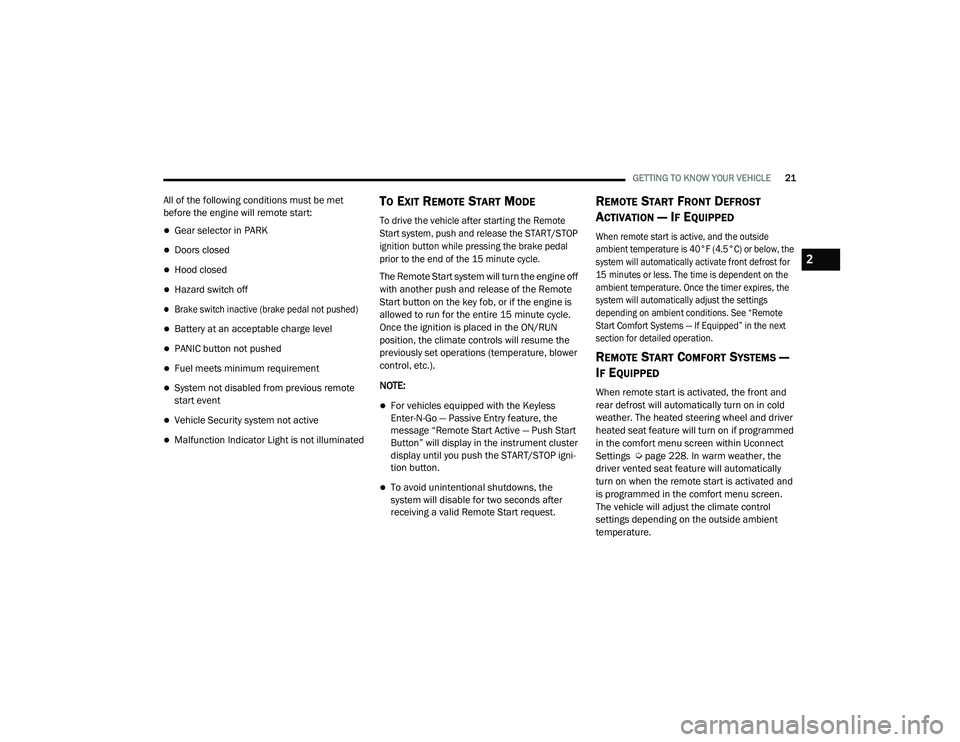
GETTING TO KNOW YOUR VEHICLE21
All of the following conditions must be met
before the engine will remote start:
Gear selector in PARK
Doors closed
Hood closed
Hazard switch off
Brake switch inactive (brake pedal not pushed)
Battery at an acceptable charge level
PANIC button not pushed
Fuel meets minimum requirement
System not disabled from previous remote
start event
Vehicle Security system not active
Malfunction Indicator Light is not illuminated
TO EXIT REMOTE START MODE
To drive the vehicle after starting the Remote
Start system, push and release the START/STOP
ignition button while pressing the brake pedal
prior to the end of the 15 minute cycle.
The Remote Start system will turn the engine off
with another push and release of the Remote
Start button on the key fob, or if the engine is
allowed to run for the entire 15 minute cycle.
Once the ignition is placed in the ON/RUN
position, the climate controls will resume the
previously set operations (temperature, blower
control, etc.).
NOTE:
For vehicles equipped with the Keyless
Enter-N-Go — Passive Entry feature, the
message “Remote Start Active — Push Start
Button” will display in the instrument cluster
display until you push the START/STOP igni -
tion button.
To avoid unintentional shutdowns, the
system will disable for two seconds after
receiving a valid Remote Start request.
REMOTE START FRONT DEFROST
A
CTIVATION — IF EQUIPPED
When remote start is active, and the outside
ambient temperature is 40°F (4.5°C) or below, the
system will automatically activate front defrost for
15 minutes or less. The time is dependent on the
ambient temperature. Once the timer expires, the
system will automatically adjust the settings
depending on ambient conditions. See “Remote
Start Comfort Systems — If Equipped” in the next
section for detailed operation.
REMOTE START COMFORT SYSTEMS —
I
F EQUIPPED
When remote start is activated, the front and
rear defrost will automatically turn on in cold
weather. The heated steering wheel and driver
heated seat feature will turn on if programmed
in the comfort menu screen within Uconnect
Settings Ú page 228. In warm weather, the
driver vented seat feature will automatically
turn on when the remote start is activated and
is programmed in the comfort menu screen.
The vehicle will adjust the climate control
settings depending on the outside ambient
temperature.
2
21_DPF_OM_EN_USC_t.book Page 21
Page 25 of 463
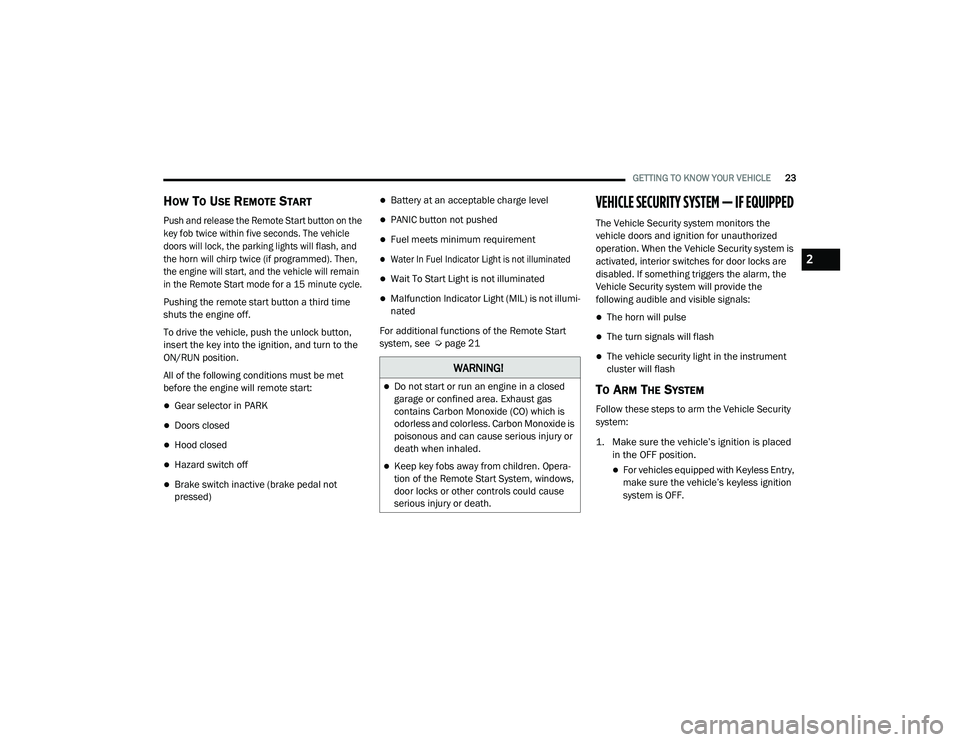
GETTING TO KNOW YOUR VEHICLE23
HOW TO USE REMOTE START
Push and release the Remote Start button on the
key fob twice within five seconds. The vehicle
doors will lock, the parking lights will flash, and
the horn will chirp twice (if programmed). Then,
the engine will start, and the vehicle will remain
in the Remote Start mode for a 15 minute cycle.
Pushing the remote start button a third time
shuts the engine off.
To drive the vehicle, push the unlock button,
insert the key into the ignition, and turn to the
ON/RUN position.
All of the following conditions must be met
before the engine will remote start:
Gear selector in PARK
Doors closed
Hood closed
Hazard switch off
Brake switch inactive (brake pedal not
pressed)
Battery at an acceptable charge level
PANIC button not pushed
Fuel meets minimum requirement
Water In Fuel Indicator Light is not illuminated
Wait To Start Light is not illuminated
Malfunction Indicator Light (MIL) is not illumi -
nated
For additional functions of the Remote Start
system, see Ú page 21
VEHICLE SECURITY SYSTEM — IF EQUIPPED
The Vehicle Security system monitors the
vehicle doors and ignition for unauthorized
operation. When the Vehicle Security system is
activated, interior switches for door locks are
disabled. If something triggers the alarm, the
Vehicle Security system will provide the
following audible and visible signals:
The horn will pulse
The turn signals will flash
The vehicle security light in the instrument
cluster will flash
TO ARM THE SYSTEM
Follow these steps to arm the Vehicle Security
system:
1. Make sure the vehicle’s ignition is placed
in the OFF position.
For vehicles equipped with Keyless Entry,
make sure the vehicle’s keyless ignition
system is OFF.
WARNING!
Do not start or run an engine in a closed
garage or confined area. Exhaust gas
contains Carbon Monoxide (CO) which is
odorless and colorless. Carbon Monoxide is
poisonous and can cause serious injury or
death when inhaled.
Keep key fobs away from children. Opera -
tion of the Remote Start System, windows,
door locks or other controls could cause
serious injury or death.
2
21_DPF_OM_EN_USC_t.book Page 23
Page 81 of 463
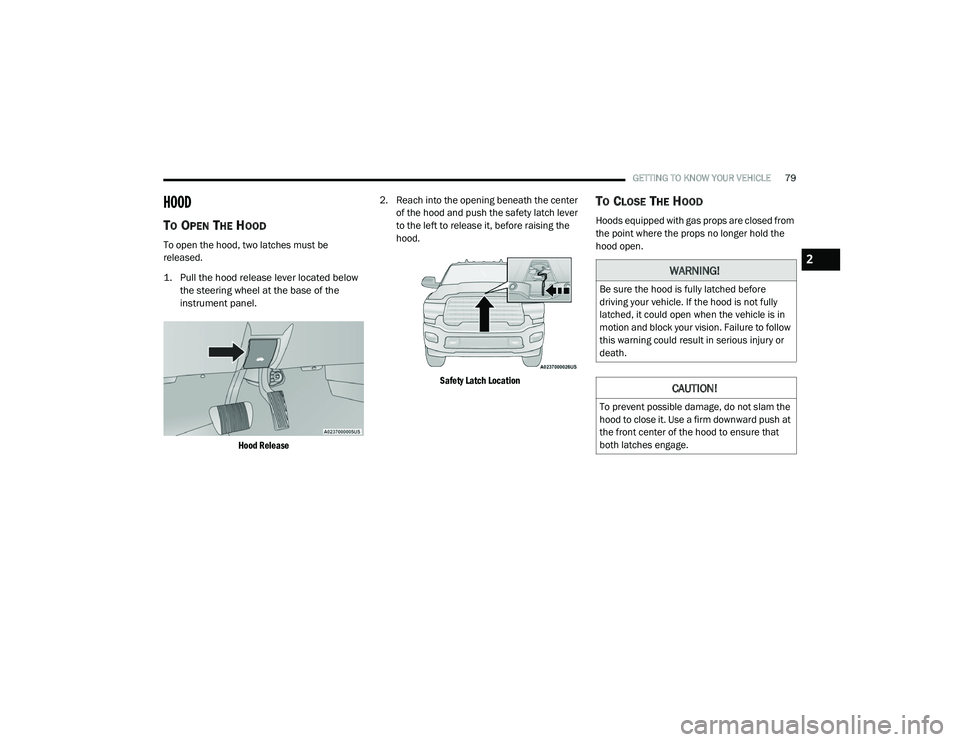
GETTING TO KNOW YOUR VEHICLE79
HOOD
TO OPEN THE HOOD
To open the hood, two latches must be
released.
1. Pull the hood release lever located below
the steering wheel at the base of the
instrument panel.
Hood Release
2. Reach into the opening beneath the center
of the hood and push the safety latch lever
to the left to release it, before raising the
hood.
Safety Latch Location
TO CLOSE THE HOOD
Hoods equipped with gas props are closed from
the point where the props no longer hold the
hood open.
WARNING!
Be sure the hood is fully latched before
driving your vehicle. If the hood is not fully
latched, it could open when the vehicle is in
motion and block your vision. Failure to follow
this warning could result in serious injury or
death.
CAUTION!
To prevent possible damage, do not slam the
hood to close it. Use a firm downward push at
the front center of the hood to ensure that
both latches engage.
2
21_DPF_OM_EN_USC_t.book Page 79
Page 127 of 463

STARTING AND OPERATING125
NOTE:
Engine idle speed will automatically increase
to 1,000 RPM and engage the Variable
Geometry Turbocharger at low coolant
temperatures to improve engine warm-up.
The engine will not automatically crank after
the engine "Wait to Start" telltale goes off if a
door or the hood is ajar.
If the engine stalls, or if the ignition switch is
left ON for more than two minutes after the
“Wait to Start” telltale goes out, reset the
intake air heater by turning the ignition switch
to the OFF position for at least 5 seconds and
then back ON. Repeat steps 1 through 6 of
“Keyless Enter-N-Go Starting Procedure –
Engine Manifold Air Temperature 0°F To 66°F
(–18°C to 19°C).”
EXTREME COLD WEATHER
The Cummins Turbo Diesel engine is equipped
with several features designed to assist cold
weather starting and operation:
The engine block heater is a resistance heater
installed in the water jacket of the engine just
above and behind the oil filter. It requires a 110–115 Volt AC electrical outlet
with a grounded, three-wire extension cord.
NOTE:
The engine block heater cord is a factory
installed option. If your vehicle is not equipped,
heater cords are available from an authorized
Mopar dealer.
A 12 Volt heater built into the fuel filter hous -
ings aid in preventing fuel gelling. It is
controlled by a built-in thermostat.
An intake air heater system both improves
engine starting and reduces the amount of
white smoke generated by a warming engine.
NORMAL STARTING PROCEDURE —
E
NGINE MANIFOLD AIR TEMPERATURE
A
BOVE 66°F (19°C)
Observe the instrument panel cluster lights
when starting the engine.
1. Always apply the parking brake.
2. Shift into PARK for an automatic
transmission. 3. Place the ignition switch in the ON position
and watch the instrument panel cluster
lights.
4. Place the ignition switch in the START position and crank the engine. Do not press
the accelerator during starting.
5. Check that the oil pressure warning light has turned off.
6. Release the parking brake.
CAUTION!
If the “Water in Fuel Indicator Light” remains
on, DO NOT START the engine before you
drain the water from the fuel filters to avoid
engine damage Ú page 375.
CAUTION!
Do not crank engine for more than 25 seconds
at a time or starter motor damage may result.
Turn the ignition switch to the OFF position and
wait at least two minutes for the starter to cool
before repeating start procedure.
4
21_DPF_OM_EN_USC_t.book Page 125
Page 382 of 463

380SERVICING AND MAINTENANCE
BODY LUBRICATION
Locks and all body pivot points, including such
items as seat tracks, door hinge pivot points
and rollers, liftgate, tailgate, decklid, sliding
doors and hood hinges, should be lubricated
periodically with a lithium-based grease, such
as Mopar Spray White Lube to ensure quiet,
easy operation and to protect against rust and
wear. Prior to the application of any lubricant,
the parts concerned should be wiped clean to
remove dust and grit; after lubricating excess,
oil and grease should be removed. Particular
attention should also be given to hood latching
components to ensure proper function. When
performing other underhood services, the hood
latch, release mechanism and safety catch
should be cleaned and lubricated.
The external lock cylinders should be lubricated
twice a year, preferably in the Autumn and
Spring. Apply a small amount of a high quality
lubricant, such as Mopar Lock Cylinder
Lubricant directly into the lock cylinder.
WINDSHIELD WIPER BLADES
Clean the rubber edges of the wiper blades and
the windshield periodically with a sponge or soft
cloth and a mild nonabrasive cleaner. This will
remove accumulations of salt or road film.
Operation of the wipers on dry glass for long
periods may cause deterioration of the wiper
blades. Always use washer fluid when using
the wipers to remove salt or dirt from a dry
windshield.
Avoid using the wiper blades to remove frost or
ice from the windshield. Keep the blade rubber
out of contact with petroleum products such as
engine oil, gasoline, etc.
NOTE:
Life expectancy of wiper blades varies
depending on geographical area and frequency
of use. Poor performance of blades may be
present with chattering, marks, water lines
or wet spots. If any of these conditions are
present, clean the wiper blades or replace as
necessary. The wiper blades and wiper arms should be
inspected periodically, not just when wiper
performance problems are experienced.
This inspection should include the following
points:
Wear or uneven edges
Foreign material
Hardening or cracking
Deformation or fatigue
If a wiper blade or wiper arm is damaged,
replace the affected wiper arm or blade with a
new unit. Do not attempt to repair a wiper arm
or blade that is damaged.
Wiper Blade Removal/Installation
CAUTION!
Do not allow the wiper arm to spring back
against the glass without the wiper blade in
place or the glass may be damaged.
21_DPF_OM_EN_USC_t.book Page 380
Page 455 of 463
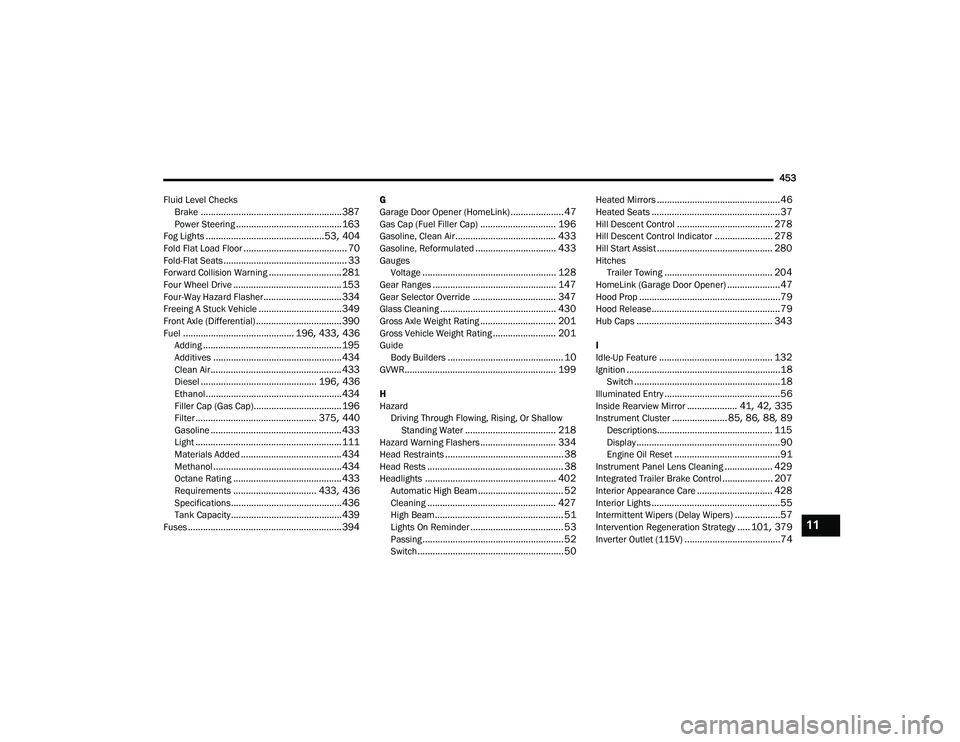
453
Fluid Level Checks Brake
........................................................ 387Power Steering.......................................... 163Fog Lights............................................... 53, 404Fold Flat Load Floor......................................... 70Fold-Flat Seats................................................. 33Forward Collision Warning............................. 281Four Wheel Drive........................................... 153Four-Way Hazard Flasher............................... 334Freeing A Stuck Vehicle................................. 349Front Axle (Differential).................................. 390Fuel............................................ 196, 433, 436Adding....................................................... 195Additives................................................... 434Clean Air.................................................... 433Diesel.............................................. 196, 436Ethanol...................................................... 434Filler Cap (Gas Cap)................................... 196Filter................................................ 375, 440Gasoline.................................................... 433Light.......................................................... 111Materials Added........................................ 434Methanol................................................... 434Octane Rating........................................... 433Requirements................................. 433, 436Specifications............................................ 436Tank Capacity............................................ 439Fuses............................................................. 394
G
Garage Door Opener (HomeLink)..................... 47Gas Cap (Fuel Filler Cap).............................. 196Gasoline, Clean Air........................................ 433Gasoline, Reformulated................................ 433GaugesVoltage..................................................... 128Gear Ranges................................................. 147Gear Selector Override................................. 347Glass Cleaning.............................................. 430Gross Axle Weight Rating.............................. 201Gross Vehicle Weight Rating......................... 201GuideBody Builders.............................................. 10GVWR............................................................ 199
H
HazardDriving Through Flowing, Rising, Or Shallow Standing Water
.................................... 218Hazard Warning Flashers.............................. 334Head Restraints............................................... 38Head Rests...................................................... 38Headlights.................................................... 402Automatic High Beam.................................. 52Cleaning................................................... 427High Beam................................................... 51Lights On Reminder..................................... 53Passing........................................................ 52Switch.......................................................... 50
Heated Mirrors.................................................46Heated Seats...................................................37Hill Descent Control...................................... 278Hill Descent Control Indicator....................... 278Hill Start Assist.............................................. 280HitchesTrailer Towing........................................... 204HomeLink (Garage Door Opener).....................47Hood Prop........................................................79Hood Release...................................................79Hub Caps...................................................... 343
I
Idle-Up Feature............................................. 132Ignition.............................................................18Switch..........................................................18Illuminated Entry..............................................56Inside Rearview Mirror.................... 41, 42, 335Instrument Cluster...................... 85, 86, 88, 89Descriptions.............................................. 115Display.........................................................90Engine Oil Reset..........................................91Instrument Panel Lens Cleaning................... 429Integrated Trailer Brake Control.................... 207Interior Appearance Care.............................. 428Interior Lights...................................................55Intermittent Wipers (Delay Wipers)..................57Intervention Regeneration Strategy..... 101, 379Inverter Outlet (115V)......................................74
11
21_DPF_OM_EN_USC_t.book Page 453
Page 458 of 463
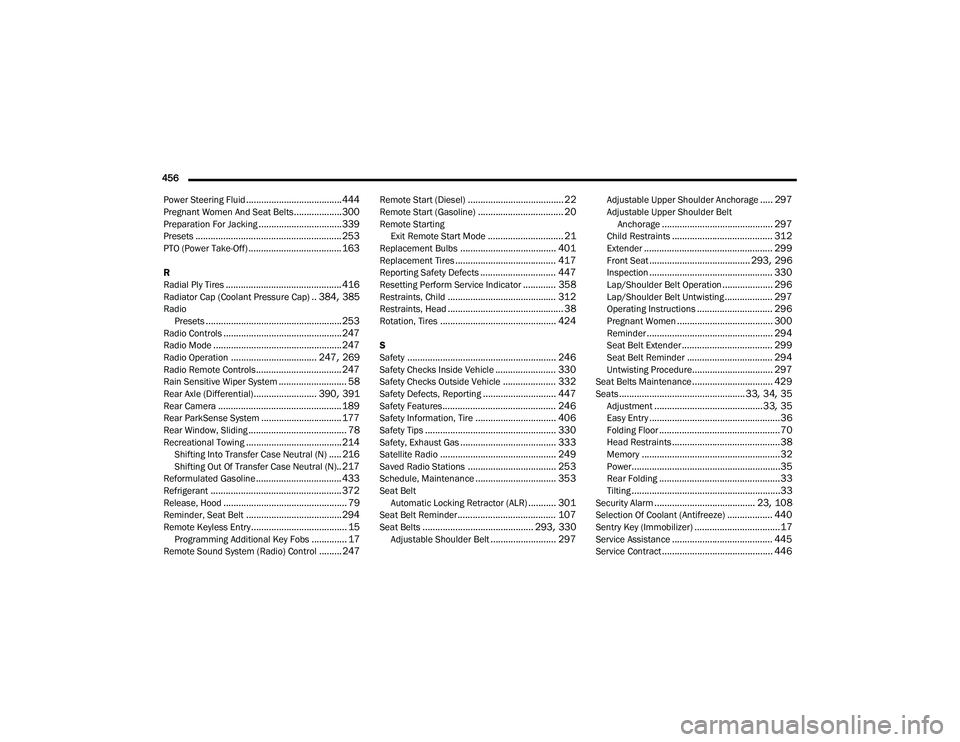
456 Power Steering Fluid
...................................... 444Pregnant Women And Seat Belts...................300Preparation For Jacking................................. 339Presets.......................................................... 253PTO (Power Take-Off)..................................... 163
R
Radial Ply Tires.............................................. 416Radiator Cap (Coolant Pressure Cap).. 384, 385Radio Presets...................................................... 253Radio Controls............................................... 247Radio Mode................................................... 247Radio Operation.................................. 247, 269Radio Remote Controls.................................. 247Rain Sensitive Wiper System........................... 58Rear Axle (Differential)......................... 390, 391Rear Camera................................................. 189Rear ParkSense System................................ 177Rear Window, Sliding....................................... 78Recreational Towing...................................... 214Shifting Into Transfer Case Neutral (N)..... 216Shifting Out Of Transfer Case Neutral (N).. 217Reformulated Gasoline.................................. 433Refrigerant.................................................... 372Release, Hood................................................. 79Reminder, Seat Belt...................................... 294Remote Keyless Entry...................................... 15Programming Additional Key Fobs.............. 17Remote Sound System (Radio) Control......... 247
Remote Start (Diesel)...................................... 22Remote Start (Gasoline).................................. 20Remote StartingExit Remote Start Mode.............................. 21Replacement Bulbs...................................... 401Replacement Tires........................................ 417Reporting Safety Defects.............................. 447Resetting Perform Service Indicator............. 358Restraints, Child........................................... 312Restraints, Head.............................................. 38Rotation, Tires.............................................. 424
S
Safety........................................................... 246Safety Checks Inside Vehicle........................ 330Safety Checks Outside Vehicle..................... 332Safety Defects, Reporting............................. 447Safety Features............................................. 246Safety Information, Tire................................ 406Safety Tips.................................................... 330Safety, Exhaust Gas...................................... 333Satellite Radio.............................................. 249Saved Radio Stations................................... 253Schedule, Maintenance................................ 353Seat BeltAutomatic Locking Retractor (ALR)........... 301Seat Belt Reminder....................................... 107Seat Belts............................................ 293, 330Adjustable Shoulder Belt.......................... 297
Adjustable Upper Shoulder Anchorage..... 297Adjustable Upper Shoulder Belt Anchorage............................................ 297Child Restraints........................................ 312Extender................................................... 299Front Seat........................................ 293, 296Inspection................................................. 330Lap/Shoulder Belt Operation.................... 296Lap/Shoulder Belt Untwisting................... 297Operating Instructions.............................. 296Pregnant Women...................................... 300Reminder.................................................. 294Seat Belt Extender.................................... 299Seat Belt Reminder.................................. 294Untwisting Procedure................................ 297Seat Belts Maintenance................................ 429Seats.................................................. 33, 34, 35Adjustment...........................................33, 35Easy Entry....................................................36Folding Floor................................................70Head Restraints...........................................38Memory.......................................................32Power...........................................................35Rear Folding................................................33Tilting...........................................................33Security Alarm........................................ 23, 108Selection Of Coolant (Antifreeze).................. 440Sentry Key (Immobilizer)..................................17Service Assistance........................................ 445Service Contract............................................ 446
21_DPF_OM_EN_USC_t.book Page 456